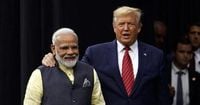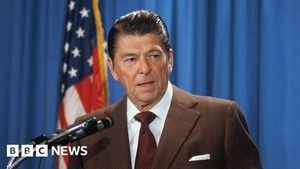In a rapidly shifting global energy landscape, India finds itself at the center of a geopolitical tug-of-war following renewed U.S. sanctions on major Russian oil companies. The latest round of sanctions, announced by President Donald Trump on October 23, 2025, targets Rosneft and Lukoil PJSC—two of Russia’s energy giants and, crucially, the primary suppliers of Russian crude to India. The move has sent ripples through international markets and triggered a swift response from Indian refiners, who are now scrambling to secure alternative sources of oil.
According to Bloomberg, Reliance Industries Ltd (RIL), India’s largest private refiner and the country’s top importer of Russian oil by volume this year, has already pivoted its procurement strategy. The company, which has long relied on a steady supply from Rosneft under a long-term agreement, recently purchased millions of barrels of crude from the Middle East and the United States. These deals, which include oil grades such as Khafji from Saudi Arabia, Basrah Medium from Iraq, Al-Shaheen from Qatar, and West Texas Intermediate from the U.S., are set to arrive in December 2025 and January 2026.
This shift comes at a time of uncertainty for Indian energy planners. As reported by The New Indian Express, India’s Ambassador to the U.S., Vinay Mohan Kwatra, met with U.S. Deputy Secretary of Energy James Danly to discuss the implications of the new sanctions and the broader India-U.S. energy partnership. A source familiar with the matter commented, “These are early days and we need more clarity on the sanctions — that’s part of the ongoing conversation with the US. Our energy security is paramount and guided by market conditions, national interests, and domestic requirements.”
While Reliance Industries has always maintained a diverse sourcing portfolio, the latest purchases are notably larger than usual. Market traders told Bloomberg that RIL bought at least 10 million barrels in October 2025 alone, with most of these post-sanctions deals involving Middle Eastern crude. Other Indian refiners are also stepping up spot market purchases, seeking shipments from the Middle East, the U.S., and even Brazil, as they brace for a potential decline in Russian oil imports.
The sanctions have also had an immediate impact on global oil prices. The Brent benchmark surged by more than 5% following the announcement, reaching $66.42 per barrel on October 24, 2025. The price rally was fueled by the sudden removal of nearly 4.5 million barrels per day from global markets due to the sanctions on Rosneft, Lukoil, and Sovcomflot—a Russian shipping company also targeted by Washington.
The situation is further complicated by the threat of secondary sanctions, which could penalize third-party countries and companies that continue to do business with Russia’s sanctioned entities. As a result, several Chinese firms have temporarily suspended their purchases of Russian oil while they assess the risks. For India, the specter of secondary sanctions has prompted a cautious yet pragmatic response. According to The New Indian Express, Indian imports of Russian oil are expected to decline gradually, with refiners increasingly turning to alternative suppliers to ensure energy security.
Still, Russia remains a key partner for India’s energy needs. Most of India’s Russian oil purchases are spot deals, with Nayara Energy—backed by Rosneft—being the notable exception, maintaining a term contract for Russian crude. Yet, as the fine print of the sanctions is still awaited, Indian officials are treading carefully. “Our attention is on US sanctions against Rosneft and Lukoil, which supply most of our Russian oil, and the possible ripple effects of secondary sanctions. The fine-print is awaited,” a government source told The New Indian Express.
India’s diplomatic outreach has also intensified. In addition to energy talks, Ambassador Kwatra met with Lockheed Martin CEO Jim Taiclet on October 26, 2025, to discuss opportunities for bilateral defense industrial collaboration under India’s Atmanirbhar Bharat (self-reliant India) initiative. While these discussions may seem unrelated on the surface, they underscore India’s broader strategy to deepen ties with the U.S. across multiple sectors in the face of shifting global alliances.
The Western approach to Russian oil sanctions has been anything but uniform. Germany, for instance, recently took temporary control of three Rosneft subsidiaries to secure its own energy supplies—highlighting the ad hoc and sometimes contradictory nature of Europe’s response. This lack of cohesion has left countries like India navigating a maze of legal and diplomatic uncertainties as they seek to balance national interests with international obligations.
For Indian policymakers, a Russia–Ukraine ceasefire would represent the best possible outcome. Not only could it pave the way for lifting the additional 25% U.S. tariff on Russian crude, but it would also provide much-needed stability to global energy markets. Until then, the Indian government is focused on ensuring that alternative supplies are sufficient to meet domestic demand, even as it keeps a watchful eye on the evolving sanctions regime.
Despite the turbulence, market fundamentals remain relatively robust. Traders told Bloomberg that prompt timespreads for Dubai’s regional benchmark have strengthened, and prices for grades like Oman have seen an uptick as Indian refiners snap up available cargoes. The diversification of India’s oil imports is also seen as a way to offset tariff pressures and lay the groundwork for an energy-focused component in the ongoing trade pact negotiations with the U.S.
As the November 21 deadline to wind down transactions with Rosneft and Lukoil approaches, Indian refiners are expected to accelerate their shift away from Russian crude. Yet, officials remain optimistic that Washington will not push the sanctions so far as to trigger a global price surge—an outcome that would hurt not only India, but also other major importers like China.
In the end, India’s response to the latest U.S. sanctions on Russian oil is a case study in pragmatic diplomacy and market adaptation. By moving quickly to secure alternative supplies and maintaining open lines of communication with both Washington and Moscow, Indian officials are working to safeguard the nation’s energy security in an increasingly unpredictable world.
For now, the world watches as India navigates this high-stakes balancing act—one that could reshape global oil flows for months, if not years, to come.




